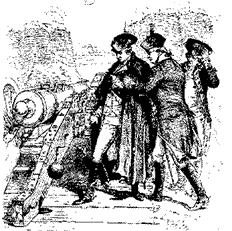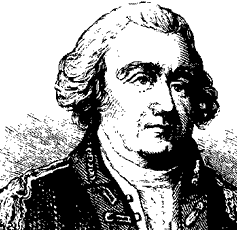
American and French artillery was a key element that led to Allied victory at Yorktown in 1781. Utilizing siege cannon, seasoned American gunners and professional French artillerists fired over 15,000 rounds into British lines during the nine day bombardment. Their effectiveness, accuracy and destructiveness helped convince Britain's Lord Cornwallis to surrender. One of the American artillery units at Yorktown was the Second Regiment of the Continental Artillery, commanded by Colonel John Lamb. Today, a volunteer living history gun crew, representing Colonel Lamb’s artillery regiment, conducts periodic firing demonstrations with a reproduction 18-pounder siege gun, commemorating the merit and distinction which Lamb’s artillery displayed during the siege of Yorktown. 
Colonel John Lamb Born in 1735 in New York City, John Lamb was the son of a former indentured servant and successful optician and businessman, Andrew Lamb. John joined his father’s business and eventually became a successful wine merchant. He also developed into an influential and captivating speaker. With the passage of the Stamp Act in 1765, John Lamb joined the Patriot cause, acquiring a reputation as a “Son of Liberty.” When news of the Battle of Lexington reached New York City, Lamb and other Patriots occupied the Customhouse and prevented ships from leaving the harbor. In July 1775, Lamb was commissioned a captain in the New York artillery, and joined General Richard Montgomery’s expedition into Canada. Captured during the attack on Quebec, Lamb was seriously wounded by close-range grapeshot. Returning home on parole in January 1777, he was exchanged. Shortly thereafter he was promoted to a colonel in the Second Regiment of the Continental Artillery. In 1778, when the Continental Army reorganized, Lamb protested what he perceived as a demotion. In an August 12th letter to General Washington, Lamb wrote, “As I conceive myself greatly injured by the board of general officers, appointed to settle the rank of officers of artillery; I must beg your excellency’s permission to resign.” Washington replied the next day, “It pains me to find an officer of your rank and merit soliciting a resignation...I repeat my wishes that you will decline your application.” Fortunately for the cause, Lamb decided to remain in the service. In 1779 and 1780, Lamb commanded the artillery at West Point, and commanded that post when General Benedict Arnold defected to the British. Although a close friend and admirer of Arnold, Lamb was outraged at Arnold’s treason, remarking, “If he [Arnold] were hanged tomorrow, I would go barefooted to witness the execution.” During the Yorktown campaign, Lamb continued to command the Second Regiment of the Continental Artillery. On October 9th, Lamb was the Officer of the Day when General Washington fired the first American cannon. During the siege, the artillery served with distinction. The artillery detachment and Lamb’s artillery in particular, were accorded high praise by both Washington and General Henry Knox, chief of artillery. A General Order from the Commander in Chief relayed his thanks and appreciation to Lamb’s artillery unit. After the British surrender, Lamb was placed in temporary command of all the artillery, and oversaw its return to New York. On September 30, 1783, Lamb was brevetted a brigadier general. On November 25, 1783, Lamb returned to New York City for the first time in eight years. He retired from the Continental Army, living off the proceeds from land grants awarded him as pay for his service. During the debates on ratification of the Constitution, he was an opponent and strong anti-federalist. Even so, his position did not prevent him from accepting appointment as Federal Collector of Customs for New York City by President Washington. In 1797, it was discovered that Lamb’s deputy had embezzled a large sum of the Custom's duties. Lamb made good the losses, resigned his position, and died in poverty and obscurity in 1800, another forgotten hero of the War for Independence.
The artillery pieces shown on the page, Revolutionary War Artillery, are located near the Yorktown Visitor Center, Colonial National Historical Park, and are similar to the ones used during the Siege of Yorktown during the War of Independence, 1781.

Lamb's Artillery Cannon Firing Demonstration
|
Last updated: February 26, 2015
